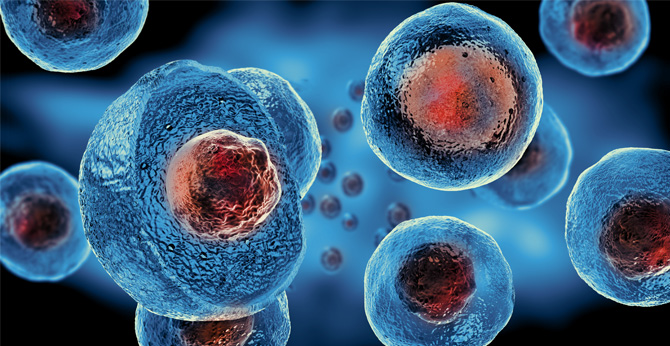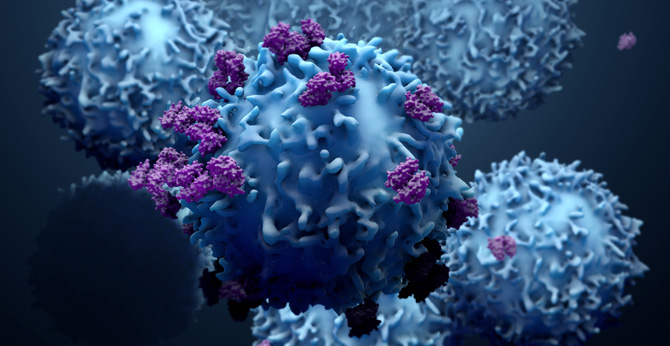All products and services are For Research Use Only and CANNOT be used in the treatment or diagnosis of disease.
Creative Biolabs provides customers with comprehensive CD133 CAR-related products to support CAR-T development. Please browse the following CD133 CAR-related products to find the appropriate product you desire.
CD133 protein, known as prominin-1, is a transmembrane protein expressed in many tumor cell types. The biological function of CD133 in normal tissues and the cancer progression is not well understood. It is known that CD133 is preferentially localized in plasma membrane processes and microvilli, suggesting that CD133 may be involved in membrane tissue-related functions. Importantly, CD133 is considered a CSC marker in both non-small cell lung cancer and small cell lung cancer, making it a hot target in disease treatment.

Fig.1 Schematic diagram of CD133 structure.1
Associated Diseases
Designing a suitable CAR structure is particularly important for the CART project. With our advanced technology platform and many years of experience, we have developed a series of potential CART design structures to accelerate CART development, including many classical CAR designs, armored CAR constructions, etc.

Fig.2 Schematic diagram of different CD133 CAR constructions.2
Anti-CD133 CAR-T Expression Test
Creative Biolabs provides extensive in vitro testing services to verify the functions of CART cells. CAR expression test is the most commonly used assay to detect the quality of CART cells. We offer a variety of CAR detection reagents and techniques to assist in CAR expression verification.

Fig.3 Analysis of the CD133 CAR expression by flow cytometry using a c-myc tag.2
Cell Viability Test of CD133 CAR-T
To detect the viability of CART cells, we offer viability assay services through a variety of methods, such as 7-AAD staining, MTT test, and Ki67 proliferation maker test.

Fig.4 Cell viability test of CD133 CAR-T cells by 7-AAD staining.2
Anti-CD133 CAR-T Cytokine Release Test
CART cells secrete and release various cytokines during incubation with target cells. Creative Biolabs provides global customers with a comprehensive range of cytokine assays, including IL-2, IL-6, IL-10, IFNγ, and TNFα, etc.

Fig.5 Cytokine detection (IFNγ and TNFα) of different CD133 CAR-T cells co-cultured with tumor cells.2
Anti-CD133 CAR-T In Vitro Cytotoxicity Assay
In vitro tumor killing assay is a very important test to verify the target specificity and effectiveness of CART cells against different tumor cells. Creative Biolabs is committed to providing comprehensive reliable and robust in vitro cytotoxicity testing services to speed CART development, such as real-time dynamic cytotoxicity tests, flow cytometry cytotoxicity tests, etc.

Fig.6 In vitro cytotoxicity test of anti-CD133 CAR-T against Hep3B cells. (E) Representative images of CD133 CAR-T cells targeting Hep3B tumor cells (Upper panel). The lower image shows the Representative images of cell proportion of CD133 CAR-T cells co-cultured with Hep3B target cells after 24 hrs (Lower panel). (F) Cytotoxicity of CAR-T cells against Hep3B tumor cells after 3 days.2
Anti-CD133 CAR-T Cell Therapy Animal Models
Based on our advanced platform and team of experienced scientists, Creative Biolabs provides one-stop CART research services to help customers quickly advance their projects. For CART in vivo study, we provide a wide range of animal models and customized experimental schemes for customers to choose from, including CDX models, PDX models, etc.

Fig.7 Schematic diagram of in vivo experimental design of anti-CD133 CAR-T cells.2
Efficacy Test of Anti-CD133 CAR-T
At the same time, we provide a variety of optimized in vivo detection methods to verify the effectiveness and safety of CART cells to ensure customers get the most authentic and reliable experimental data.

Fig.8 Efficacy test of anti-CD133 CAR-T in Hep3B xenograft mouse models by BLI.2
References
 Loading...
Loading...
| CAT | Product Name | Target Species | Antibody Clone | Antibody Host | Receptor Construction | Vector Type | Targeting Cell Type | CAR Vector Type | Inquiry & Datasheet |
| CAR-ZP030 | Anti-CD133 (F7F9) h(CD28-CD3ζ) CAR, pCDCAR1 | Human | F7F9 | Mouse | scFv-CD28-CD3ζ | Lentiviral vector | T cell | ||
| CAR-ZP056 | Anti-CD133 (F7F9) h(41BB-CD3ζ) CAR, pCDCAR1 | Human | F7F9 | Mouse | scFv-4-1BB-CD3ζ | Lentiviral vector | T cell | ||
| CAR-ZP192 | Anti-CD133 () h(CD28-CD3ζ) CAR, pCDCAR1 | Human | Mouse | scFv-CD28-CD3ζ | Lentiviral vector | T cell | |||
| CAR-ZP193 | Anti-CD133 () h(41BB-CD3ζ) CAR, pCDCAR1 | Human | Mouse | scFv-4-1BB-CD3ζ | Lentiviral vector | T cell | |||
| CAR-ZP5133 | Anti-CD133 (3D4) h(CD28-CD3ζ) CAR, pCDCAR1 | Human | 3D4 | Mouse | scFv-CD28-CD3ζ | Lentiviral vector | T cell | ||
| CAR-ZP5134 | Anti-CD133 (3D4) h(41BB-CD3ζ) CAR, pCDCAR1 | Human | 3D4 | Mouse | scFv-41BB-CD3ζ | Lentiviral vector | T cell | ||
| CAR-ZP5135 | Anti-CD133 (2F4) h(CD28-CD3ζ) CAR, pCDCAR1 | Human | 2F4 | Mouse | scFv-CD28-CD3ζ | Lentiviral vector | T cell | ||
| CAR-ZP5136 | Anti-CD133 (2F4) h(41BB-CD3ζ) CAR, pCDCAR1 | Human | 2F4 | Mouse | scFv-41BB-CD3ζ | Lentiviral vector | T cell | ||
| CAR-ZP5137 | Anti-CD133 (6H10-F1-C11) h(CD28-CD3ζ) CAR, pCDCAR1 | Human | 6H10-F1-C11 | Mouse | scFv-CD28-CD3ζ | Lentiviral vector | T cell | ||
| CAR-ZP5138 | Anti-CD133 (6H10-F1-C11) h(41BB-CD3ζ) CAR, pCDCAR1 | Human | 6H10-F1-C11 | Mouse | scFv-41BB-CD3ζ | Lentiviral vector | T cell | ||
| CAR-ZP5139 | Anti-CD133 (8F2-H6-D6) h(CD28-CD3ζ) CAR, pCDCAR1 | Human | 8F2-H6-D6 | Mouse | scFv-CD28-CD3ζ | Lentiviral vector | T cell | ||
| CAR-ZP5167 | Anti-CD133 (SDIE293) h(CD28-CD3ζ) CAR, pCDCAR1 | Human | SDIE293 | Mouse | scFv-CD28-CD3ζ | Lentiviral vector | T cell | ||
| CAR-ZP5168 | Anti-CD133 (SDIE293) h(41BB-CD3ζ) CAR, pCDCAR1 | Human | SDIE293 | Mouse | scFv-41BB-CD3ζ | Lentiviral vector | T cell | ||
| CAR-ZP5169 | Anti-CD133 (W6B3H10) h(CD28-CD3ζ) CAR, pCDCAR1 | Human | W6B3H10 | Mouse | scFv-CD28-CD3ζ | Lentiviral vector | T cell | ||
| CAR-ZP5170 | Anti-CD133 (W6B3H10) h(41BB-CD3ζ) CAR, pCDCAR1 | Human | W6B3H10 | Mouse | scFv-41BB-CD3ζ | Lentiviral vector | T cell | ||
| CAR-ZP5171 | Anti-CD133 (SDIEW6B3) h(CD28-CD3ζ) CAR, pCDCAR1 | Human | SDIEW6B3 | Mouse | scFv-CD28-CD3ζ | Lentiviral vector | T cell | ||
| CAR-ZP5172 | Anti-CD133 (SDIEW6B3) h(41BB-CD3ζ) CAR, pCDCAR1 | Human | SDIEW6B3 | Mouse | scFv-41BB-CD3ζ | Lentiviral vector | T cell | ||
| CAR-ZP5173 | Anti-CD133 (Clone7) h(CD28-CD3ζ) CAR, pCDCAR1 | Human | Clone7 | Mouse | scFv-CD28-CD3ζ | Lentiviral vector | T cell | ||
| CAR-ZP5174 | Anti-CD133 (Clone7) h(41BB-CD3ζ) CAR, pCDCAR1 | Human | Clone7 | Mouse | scFv-41BB-CD3ζ | Lentiviral vector | T cell | ||
| CAR-ZP5175 | Anti-CD133 (MB9-3G8) h(CD28-CD3ζ) CAR, pCDCAR1 | Human | MB9-3G8 | Rat | scFv-CD28-CD3ζ | Lentiviral vector | T cell |
 NEWSLETTER
NEWSLETTER
The latest newsletter to introduce the latest breaking information, our site updates, field and other scientific news, important events, and insights from industry leaders
LEARN MORE NEWSLETTER NEW SOLUTION
NEW SOLUTION
CellRapeutics™ In Vivo Cell Engineering: One-stop in vivo T/B/NK cell and macrophage engineering services covering vectors construction to function verification.
LEARN MORE SOLUTION NOVEL TECHNOLOGY
NOVEL TECHNOLOGY
Silence™ CAR-T Cell: A novel platform to enhance CAR-T cell immunotherapy by combining RNAi technology to suppress genes that may impede CAR functionality.
LEARN MORE NOVEL TECHNOLOGY NEW SOLUTION
NEW SOLUTION
Canine CAR-T Therapy Development: From early target discovery, CAR design and construction, cell culture, and transfection, to in vitro and in vivo function validation.
LEARN MORE SOLUTION